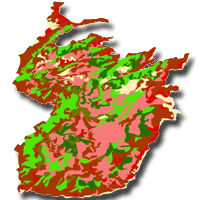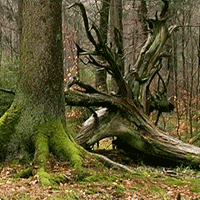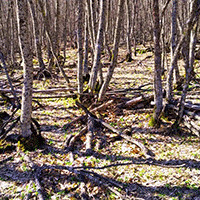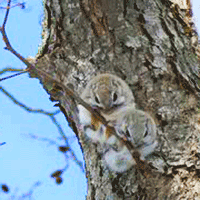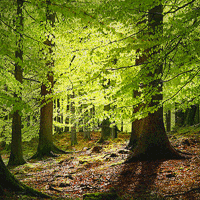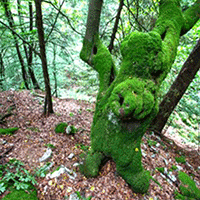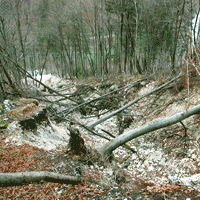Deadwood in forests plays a critical role in maintaining the ecological functions. Small mammals use deadwood, and thus deadwood can mitigate the negative impacts of plantation on small mammals. This study focused on fallen dead trees in planted forests, and aimed to verify whether fallen dead trees affect behavioral patterns of Japanese squirrels. To clarify the use of fallen dead trees by Japanese squirrels in a Japanese cedar plantation, we observed squirrel behavior by camera trap surveys at 61 survey sites. Our findings showed that fallen dead trees play a crucial role in the behavior of Japanese squirrels, serving as landmarks for movement, vigilance, resting, and hoarding sites. These functions are critical for the survival of Japanese squirrels, suggesting that fallen dead trees in planted forests have positive impacts on their microenvironment use. The increase of deadwood due to disturbances such as heavy rainfall and snowfall resulting from climate change may provide benefits to arboreal small mammals in poorly managed planted forests. Additionally, leaving some of the deadwood generated during the harvesting process in properly managed forests can improve the quality of habitat for arboreal small mammals.
Keywords
, , , , ,
Citation
Honda S, Saito MU (2023). Use of fallen dead trees by Japanese squirrels within cedar plantations in northeastern Japan. iForest 16: 262-267. - doi: 10.3832/ifor4338-016
Academic Editor
Mirko Di Febbraro
Paper history
Received: Mar 01, 2023
Accepted: Jul 23, 2023
First online: Oct 19, 2023
Publication Date: Oct 31, 2023
Publication Time: 2.93 months
© SISEF - The Italian Society of Silviculture and Forest Ecology 2023
Open Access
This article is distributed under the terms of the Creative Commons Attribution-Non Commercial 4.0 International (https://creativecommons.org/licenses/by-nc/4.0/), which permits unrestricted use, distribution, and reproduction in any medium, provided you give appropriate credit to the original author(s) and the source, provide a link to the Creative Commons license, and indicate if changes were made.

Breakdown by View Type
(Waiting for server response...)
Article Usage
Total Article Views: 16152
(from publication date up to now)
Breakdown by View Type
HTML Page Views: 12990
Abstract Page Views: 1732
PDF Downloads: 1111
Citation/Reference Downloads: 2
XML Downloads: 317
Web Metrics
Days since publication: 788
Overall contacts: 16152
Avg. contacts per week: 143.48
Article Citations
Article citations are based on data periodically collected from the Clarivate Web of Science web site
(last update: Mar 2025)
(No citations were found up to date. Please come back later)
Publication Metrics
by Dimensions ©
Articles citing this article
List of the papers citing this article based on CrossRef Cited-by.
(1)
Bakker VJ (2006)Microhabitat features influence the movements of red squirrels (
Tamiasciurus hudsonicus) on unfamiliar ground. Journal of Mammalogy 87: 124-130.
CrossRef |
Gscholar
(2)
Burns ML, Smith M, Slade EM, Ennos RA (2014)The saproxylic activity index: a new tool for the rapid assessment of deadwood species during forest restoration. Open Journal of Forestry 4: 144-150.
CrossRef |
Gscholar
(3)
Cudworth NL, Koprowski JL (2011)Importance of scale in nest-site selection by Arizona gray squirrels. The Journal of Wildlife Management 75: 1668-1674.
CrossRef |
Gscholar
(4)
Deguchi Y, Kamimizu A, Nishi C (2017)Selection of feeding location after food collection of the Japanese squirrel in Takamatsu Park, Morioka, Iwate Prefecture. Bulletin of the Iwate University Forests 48: 41-46. [In Japanese with English summary]
Gscholar
(5)
Dormann CF, Elith J, Bacher S, Buchmann C, Carl G, Carré G, Marquéz JRG, Gruber B, Lafourcade B, Leitão PJ, Münkemüller T, McClean C, Osborne PE, Reineking B, SchröDer B, Skidmore AK, Zurell D, Lautenbach S (2013)Collinearity: a review of methods to deal with it and a simulation study evaluating their performance. Ecography 36: 27-46.
CrossRef |
Gscholar
(6)
Douglass NJ, Reinert HK (1982)The utilization of fallen logs as runways by small mammals. Proceedings of the Pennsylvania Academy of Science 56: 162-164.
Gscholar
(7)
Evans AM, Perschel RT, Kittler BA (2013)Overview of forest biomass harvesting guidelines. Journal of Sustainable Forestry 32: 89-107.
CrossRef |
Gscholar
(8)
Fauteux D, Imbeau L, Drapeau P, Mazerolle MJ (2012)Small mammal responses to coarse woody debris distribution at different spatial scales in managed and unmanaged boreal forests. Forest Ecology and Management 266: 194-205.
CrossRef |
Gscholar
(9)
Ferron J (1983)Scent marking by cheek rubbing in the northern flying squirrel (
Glaucomys sabrinus). Canadian Journal of Zoology 61: 2377-2380.
CrossRef |
Gscholar
(10)
Fitzgerald VJ, Wolff JO (1988)Behavioral responses of escaping
Peromyscus leucopus to wet and dry substrata. Journal of Mammalogy 69: 825-828.
CrossRef |
Gscholar
(11)
Gray SM, Roloff GJ, Dennhardt AJ, Dotters BP, Engstrom TT (2019)Within-patch structures influence small mammal abundance in managed forests of Northern California, USA. Forest Science 65: 796-804.
CrossRef |
Gscholar
(12)
Halloran ME, Bekoff M (1995)Cheek rubbing as grooming by Abert squirrels. Animal Behaviour 50: 987-993.
CrossRef |
Gscholar
(13)
Harmon ME, Franklin JF, Swanson FJ, Sollins P, Gregory SV, Lattin JD, Anderson NH, Cline SP, Aumen NG, Sedell JR, Lienkaemper GW, Cromack K, Cummins KW (1986)Ecology of coarse woody debris in temperate ecosystems. Advances in Ecological Research 15: 133-302.
CrossRef |
Gscholar
(14)
Harmon ME, Fasth BG, Yatskov M, Kastendick D, Rock J, Woodall CW (2020)Release of coarse woody detritus-related carbon: a synthesis across forest biomes. Carbon Balance and Management. 15: 1.
CrossRef |
Gscholar
(15)
Honda S, Saito MU, Watabe R, Watanabe K (2022)Winter habitat selection of Japanese squirrels in a snowy region of northeastern Japan. Landscape and Ecological Engineering 18: 421-428.
CrossRef |
Gscholar
(16)
Honda S, Saito MU (2023)Cedar plantations as habitat for Japanese squirrels in the cool temperate zone. Journal of Vertebrate Biology 72: 23021.
CrossRef |
Gscholar
(17)
Hunter MLJ (1990)Wildlife, forests, and forestry: principles of managing forests for biological diversity. Prentice Hall, Englewood Cliffs, New Jersey, USA, pp. 370.
Online |
Gscholar
(18)
Inagaki H (1999)An occurrence of trees fallen by storm due to the difference of the vegetation and the following slope failures. Journal of the Japan Society of Engineering Geology 40: 196-206. [In Japanese with English summary]
Gscholar
(19)
Japan Meteorological Agency (2020)Normal Value 2020. Web site.
Online |
Gscholar
(20)
Japan Meteorological Agency (2022)Climate change monitoring report 2021. Web site.
Online |
Gscholar
(21)
Kato J (1985)Food and hoarding behavior of Japanese squirrels. Japanese Journal of Ecology 35: 13-20.
CrossRef |
Gscholar
(22)
Leger DW, Owings DH, Coss RG (1983)Behavioral ecology of time allocation in California ground squirrels (
Spermophilus beecheyi): microhabitat effects. Journal of Comparative Psychology 97: 283-291.
CrossRef |
Gscholar
(23)
McAdam AG, Kramer DL (1998)Vigilance as a benefit of intermittent locomotion in small mammals. Animal Behaviour 55: 109-117.
CrossRef |
Gscholar
(24)
Minami Y, Onodera K, Murao N, Yoshikawa T (2019)Eurasian red squirrels use woodpiles on the forest floor in eastern Hokkaido. The Natural Environmental Science Research 32: 21-25.
CrossRef |
Gscholar
(25)
Nishigaki M, Kawamichi T (1996)Japanese squirrel. In: “The Encyclopedia of Animals in Japan 1: Mammals I”. Heibonsha, Tokyo, Japan. [In Japanese]
Gscholar
(26)
Ohba M, Sugimoto S (2020)Impacts of climate change on heavy wet snowfall in Japan. Climate Dynamics 54: 3151-3164.
CrossRef |
Gscholar
(27)
Onodera H (1990)Snow and forest. Forest Development Technological Institute, Tokyo, Japan, pp. 81. [In Japanese]
Gscholar
(28)
R Development Core Team (2019)R: a language and environment for statistical computing. R Foundation for Statistical Computing, Vienna, Austria.
Online |
Gscholar
(29)
Seip CR, Hodder DP, Crowley SM, Johnson CJ (2018)Use of constructed coarse woody debris corridors in a clearcut by American martens (
Martes americana) and their prey. Forestry 91: 506-513.
CrossRef |
Gscholar
(30)
Smith AA, Mannan RW (1994)Distinguishing characteristics of Mount Graham red squirrel midden sites. The Journal of Wildlife Management 58: 437-445.
CrossRef |
Gscholar
(31)
Sun Y, Jia W, Zhu W, Zhang X, Saidahemaiti S, Hu T, Guo H (2022)Local neural-network-weighted models for occurrence and number of down wood in natural forest ecosystem. Scientific Reports 12: 6375.
CrossRef |
Gscholar
(32)
Suyama M (1993)Fracture mechanism of windfall and wind-breakage trees in storm beaten forest. Water Science 37: 25-53. [In Japanese]
Gscholar
(34)
Tamura N (1997)Japanese squirrels as a seed disperser of walnuts. Primate Research 13: 129-135.
CrossRef |
Gscholar
(35)
Yamada T, Yoshida S, Hosaka T, Okuda T (2016)Logging residues conserve small mammalian diversity in a Malaysian production forest. Biological Conservation 194: 100-104.
CrossRef |
Gscholar
(36)
Yasuda M (2004)Monitoring diversity and abundance of mammals with camera traps: a case study on Mount Tsukuba, central Japan. Mammal Study 29: 37-46.
CrossRef |
Gscholar
(37)
Yatake H (2016)Movement on canopy and ground of Japanese squirrels. Journal of The Japanese Wildlife Research Society 41: 51-58. [In Japanese with English summary]
CrossRef |
Gscholar
(38)
Yatake H, Akita T, Abe M (1999)Space use by introduced Japanese squirrels (
Sciurus lis Temminck) in Shimizu Park. Mammalian Science 39: 9-22. [In Japanese with English summary]
CrossRef |
Gscholar
(39)
Yatake H, Tamura N (2001)To make guidelines for the Japanese squirrel conservation. III - Ecological studies on conserving the Japanese squirrel. Mammalian Science 41: 149-157. [In Japanese]
CrossRef |
Gscholar
(40)
Yoshida K, Saito MU (2022)Behavioral response of wild mammals to pre-existing and artificial latrines of raccoon dogs in northeastern Japan. Mammalia 86: 48-56.
CrossRef |
Gscholar
(41)
Yoshioka T, Suzuki Y (2012)Unutilized resource amount of forest biomass. Journal of the Japan Forest Engineering Society 27: 111-117. [In Japanese]
Gscholar



